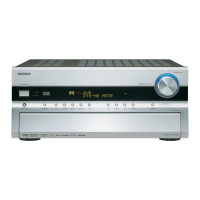39
Connecting the AV Receiver/AV Amplifier—Continued
With u (Remote Interactive), you can use the follow-
ing special functions:
■ Auto Power On/Standby
When you start playback on a component connected
via u, if the AV receiver/AV amplifier is on
Standby, it will automatically turn on and select that
component as the input source. Similarly, when the
AV receiver/AV amplifier is set to Standby, all com-
ponents connected via u will also go on Standby.
■ Direct Change
When playback is started on a component connected
via u, the AV receiver/AV amplifier automatically
selects that component as the input source. If your
DVD player is connected to the AV receiver/AV
amplifier’s DVD multichannel input, you’ll need to
press the [MULTI CH] button repeatedly and select
“Multich” to hear all channels (see page 57), as the
Direct Change u function selects the DVD
FRONT L/R jacks.
■ Remote Control
You can use the AV receiver/AV amplifier’s remote
controller to control your other u-capable Onkyo
components, pointing the remote controller at the
AV receiver/AV amplifier’s remote control sensor
instead of the component. You must enter the appro-
priate remote control code first (see page 106).
Notes:
•Use only u cables for u connections. u cables
are supplied with Onkyo players (DVD, CD, etc.).
• Some components have two u jacks. You can con-
nect either one to the AV receiver/AV amplifier. The
other jack is for connecting additional u-capable
components.
• Connect only Onkyo components to u jacks. Con-
necting other manufacturer’s components may cause a
malfunction.
• Some components may not support all u functions.
Refer to the manuals supplied with your other Onkyo
components.
• While Zone 2 is on, the Auto Power On/Standby and
Direct Change u functions do not work.
Notes:
• Before connecting the power cord, connect all of
your speakers and AV components.
• Turning on the AV receiver/AV amplifier may cause a
momentary power surge that might interfere with
other electrical equipment on the same circuit. If this
is a problem, plug the AV receiver/AV amplifier into a
different branch circuit.
• Do not use a power cord other than the one supplied
with the AV receiver/AV amplifier. The supplied
power cord is designed exclusively for use with the
AV receiver/AV amplifier and should not be used with
any other equipment.
• Never disconnect the power cord from the AV
receiver/AV amplifier while the other end is still
plugged into a wall outlet. Doing so may cause an
electric shock. Always disconnect the power cord
from the wall outlet first, and then the AV receiver/AV
amplifier.
Connecting Onkyo u Components
Step 1:
Make sure that each Onkyo component is connected
to the AV receiver/AV amplifier with an analog audio
cable (connection in the hookup examples) (see
pages 25 to 36).
Step 2:
Make the u connection (see illustration below).
Step 3:
If you’re using an MD, CDR, or RI Dock, change the
Input Display (see page 50).
a
Connecting the Power Cord
LR
FRONT
DVD
L
R
IN
CD
L
R
REMOTE
CONTROL
ANALOG
AUDIO OUT
LR
ANALOG
AUDIO OUT
e.g., CD player
e.g., DVD player
Step 1:
Connect the supplied power cord to the AV
receiver/AV amplifier’s AC INLET.
Step 2:
Plug the power cord into an AC wall outlet.
To AC wall outlet
TX-SR806_En.book Page 39 Monday, August 4, 2008 10:25 AM

